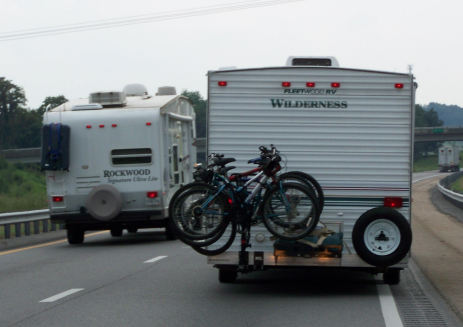Keep Your Loaded Bumper From Hitting the Road When You Do This Summer With These Simple Solutions
 We’ve all heard tales of the dreaded RV bumper failure; most often it’s the family heading out with their new camper and a bike rack clamped to their square bumper. If they’re lucky, they discover the imminent failure at a fuel stop as they do their walk-around, staring wide-eyed at their bicycle investment dangling inches from the pavement. In many cases, though, the discovery occurs at the campsite, as the kids race around to the back to get their bikes, only to discover the bikes, bike rack, and bumper all missing.
We’ve all heard tales of the dreaded RV bumper failure; most often it’s the family heading out with their new camper and a bike rack clamped to their square bumper. If they’re lucky, they discover the imminent failure at a fuel stop as they do their walk-around, staring wide-eyed at their bicycle investment dangling inches from the pavement. In many cases, though, the discovery occurs at the campsite, as the kids race around to the back to get their bikes, only to discover the bikes, bike rack, and bumper all missing.
Conventional wisdom cautions against using your 4-inch square bumper to carry cargo which, if the bumper is left unsupported, is sage advice. The best advice, though, is to understand the limitations of your bumper, the dynamics at work as you travel down the road, and the options available to prevent bumper failure.
Believe it or not, a square tube bumper such as that found on many travel trailers (and some motor coaches) is pound-for-pound a very strong structural unit. The most obvious example of the strength of a square tube would be the tens of thousands of van semitrailers on the highway today. If you look closely at these vehicles, you will see that they have no frame underneath them (other than a short piece for attaching the wheel carriages to the underside of the van body). The 50,000 pounds of cargo within the trailer is carried exclusively by the thin-walled square tube that is the trailer body. The walls on some of these trailers are only 3/4 inch thick reinforced plywood which, for a wall height of over 8 feet, is proportionally 2 times thinner than the 18-gauge (0.0478”) wall of the 4-inch square RV bumper.
So, why do RV bumpers tear loose when loaded with cargo? Lack of proper attachment and support. Most bumpers are welded to the end of the RV’s frame, creating a cantilevered mount with the majority of the stress from the load focused at the topmost point of the bumper-to-frame weld. A loaded bumper not only tries to pull away from the frame at this point, it also becomes out-of-square as the load pulls the vertical wall furthest from the frame downward, creating a non-square parallelogram. This out-of-square state can most clearly be detected when the bumper’s end caps pop loose during travel. These stresses and the way they’re focused, combined with the cyclical loading caused by the bumps, potholes, and undulations of the road, combine to fatigue the metal at the weld, causing cracks that grow rapidly, eventually allowing the bumper to tear loose from the frame.
While in the past the only solution to reinforce one’s bumper was to hire a welder and invest $300-400 in bracing and gusseting, the good news is that now a significantly less expensive solution exists. Our SafetyStruts™ Bumper Support Brackets are “U” shaped brackets that bolt to your frame, allowing you to realize the full load-carrying potential of your square tube bumper. Because SafetyStruts™ cradle the bumper, supporting it along the bottom and rearmost vertical faces, the stresses on the bumper’s welds are effectively eliminated while at the same time the bumper’s square shape is maintained. Feedback from those who have used SafetyStruts™ on their travels and based upon thousands and thousands of miles of real-world experience is overwhelmingly positive. In most cases, installation is a breeze, requiring only a drill, a sharp bit, a couple of wrenches, and taking about a half-hour. Want to go even beefier? Check out our all-aluminum replacement bumpers, available in 4-inch and 6-inch heights. Once your bumper is properly reinforced or replaced, you can safely add the bumper-mounted cargo accessories so popular with campers today, such as receiver hitches, generator/cargo trays, and weatherproof cargo boxes.
Don’t spend another minute or nail-biting mile traveling with an unsupported bumper.

